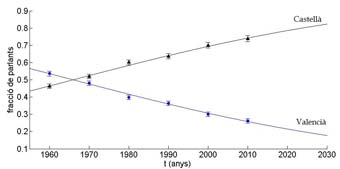
Clara Miralles Vila, a physics student who has done an undergraduate degree final project directed by the professor Manel Perucho, has overtaken both the benevolent discourse on the Valencian language golden future and that warning us of an early demise, if public policies remain unchanged. Miralles has developed a quantitative description and a repercussion grounded on scientific models which she has refined for this object of study.
The study is based on data provided by surveys of the Servici d’Investigació i Estudis Sociolingüístics - SIES-(Research and Sociolinguistic Studies Service) of the Valencian Government and the Valencian Academy of Language.
Measuring the competitive dynamics that are established between the use of languages in a multilingual society, such as the Valencian society, with a simulation made from physical models with mathematical systems, is an unusual method of studying a social fact of which our society has been talking a lot --but instead, has measured very little.
In her analysis, Miralles has used two mathematical studies to describe the sociolinguistic and competitive situation between the Valencian language and Spanish in our territory. The first, the Abrams-Strogatz model, takes into account a system composed by two languages in competition: Valencian and Spanish, in our case. This model proposes that the number of speakers of each language is also determined by a parameter indicating the attractiveness of this, in other words, the social or economic opportunities that the language offers to its speakers. In this model, the equation shows that according to this uneven attractiveness, a language disappears for the prevalence of another.
The second model of study, that of J. Mira and A. Paredes, is an improved version of the former, since it exceeds the two language blocks and incorporates a third group of speakers: bilinguals. In addition, it predicts that bilingualism will be maintained according to the degree of similarity between the two competing languages and that the transfer of a speaker from one language to the other often pass over an intermediate state, bilingualism, and this state will be more stable the more similar are the two languages.
“The data processed in the project show a clear decreasing trend in the use of Valencian language, trend which, according to the approaches of the model, could lead to its reduction and possible demise. Although any model is a simplification of reality, they can be very useful in predicting future situations which could be reached if the prevailing patterns are not changed and appropriate political and social measures are not taken to remedy this situation”, says Clara Miralles.
Among the results taken from this research, we find the importance of parameters such as social status and the similarity of languages. The Mira-Paredes model “predicts that one of the two languages ends up disappearing, in our case, the Valencian language, and also that the bilingual group is not stable and, therefore, it will also disappear”, states Miralles in her research.
For Ernest Querol, sociolinguist and consultant of the Open University of Catalonia (UOC), “Clara Miralles, supervised by the professor Manel Perucho, has had the good sense to harmonise the mathematics, physics and sociology of the language in her undergraduate degree final project. And also the aim of finding the right balance between simplicity and complexity, without making the latter too simple, which is what had happened to the well-known Abrams and Strogatz model. She had to add complexity because these authors did not consider people who speak two languages. Miralles describes accurately the sociolinguistic reality, a fact that allows her to look into the future and alert that in order to prevent the lowering of Valencian language we must to implement firm and supporting policies.”
According to the sources consulted, nearly 6,000 languages coexist in the world currently, of which 4% are spoken by 96% of the population, while 25% have fewer than 1,000 speakers. The most optimistic expectations say that at the end of this century half of the languages will disappear, but the most pessimists predict that 90% of today’s languages will disappear. Miralles concludes her project making it clear that if the trend continues according to the Abrams-Strogatz model over the next years, in 2050 the percentage of Valencian speakers will be less than 10%.
Rafael Castelló, director of the Language Policy Service of the University of Valencia, has declared in reference to the project by Miralles: “It is extremely interesting to see how the social situation of Valencian language concerns and pose questions to researchers of any discipline: it makes clear the existing social concern in the Valencian Country, given the policies implemented by successive regional governments. The obtained results also illustrate, once again, the need to keep conscious policies to redirect the evolution that the events could follow if we do not commit ourselves collectively. This research shows that if we let our language uses of the will of individual choices, according to market rules, the future will be rather short and, therefore, the collective commitment is required. In this sense, the University of Valencia, with its language policy, wants to take on this commitment with the Valencian society”.
Finally, Clara Miralles, graduated in Physics from the University of Valencia, highlights the need for collaboration between sociolinguistics, physicists, and mathematician to refine models with respect to the social reality and reflect on the meaning of the results.
Last update: 29 de september de 2014 07:00.
News release


















